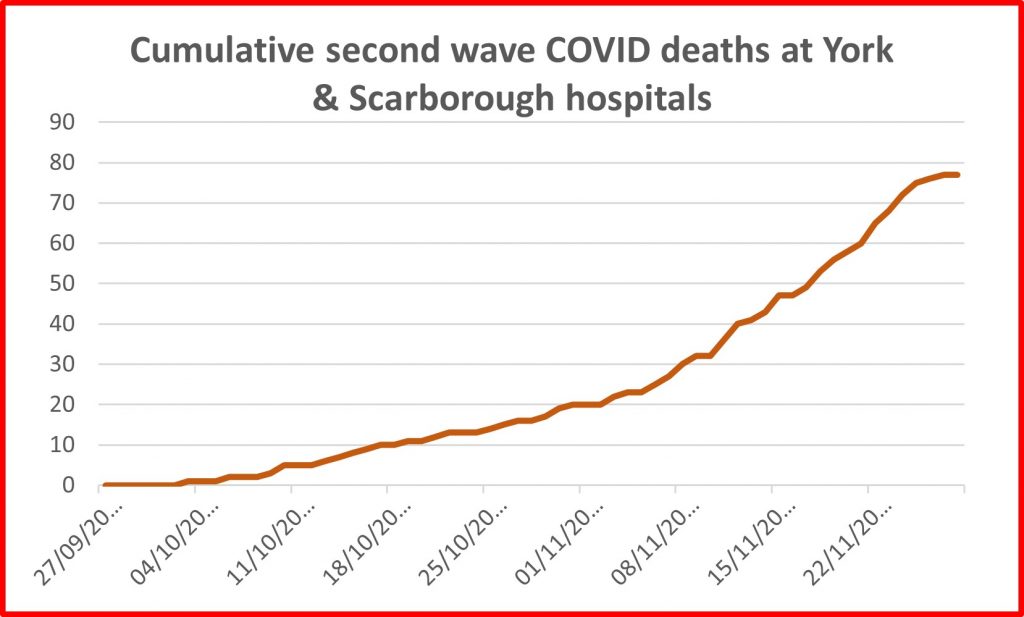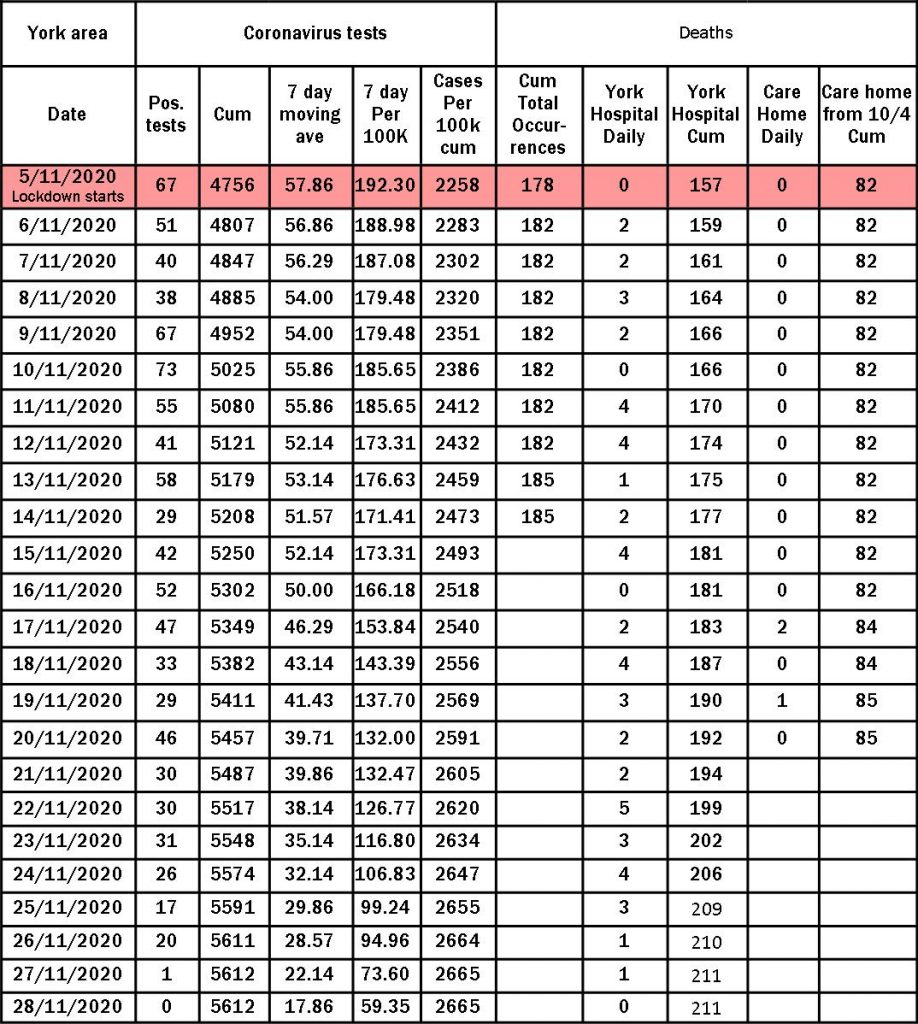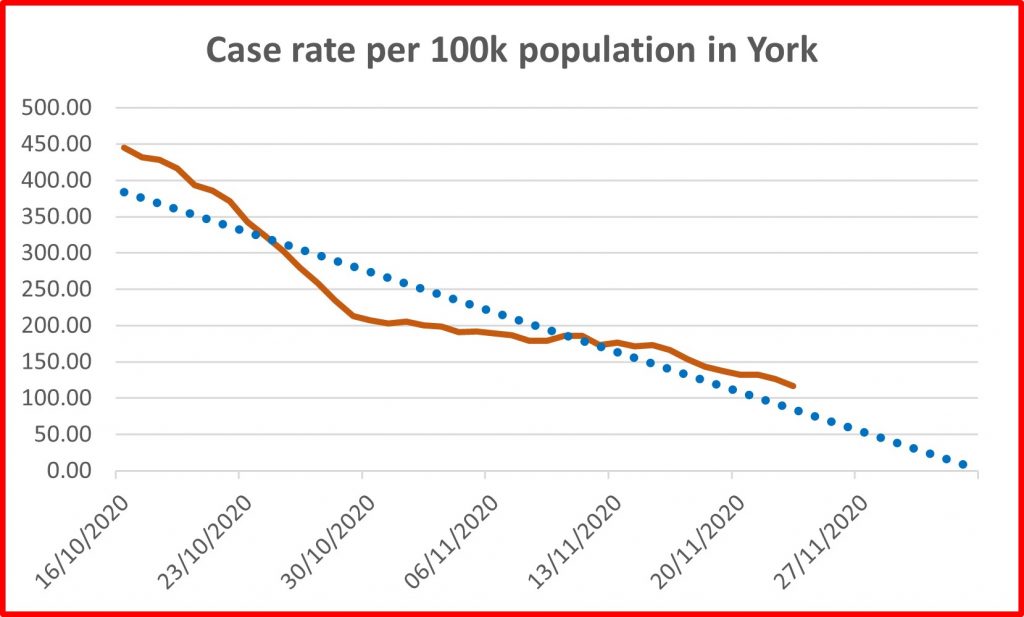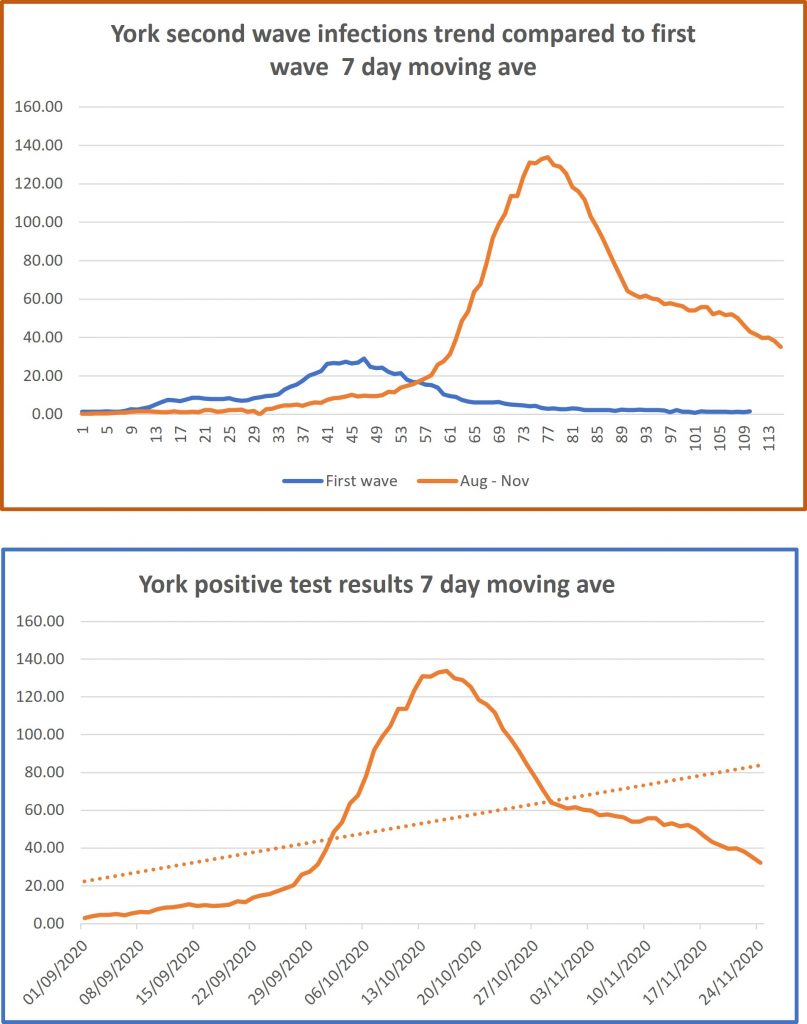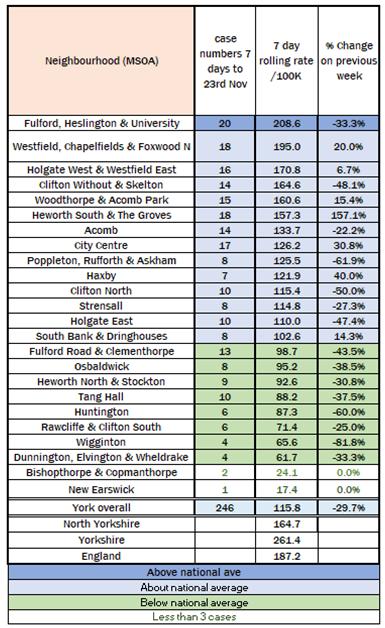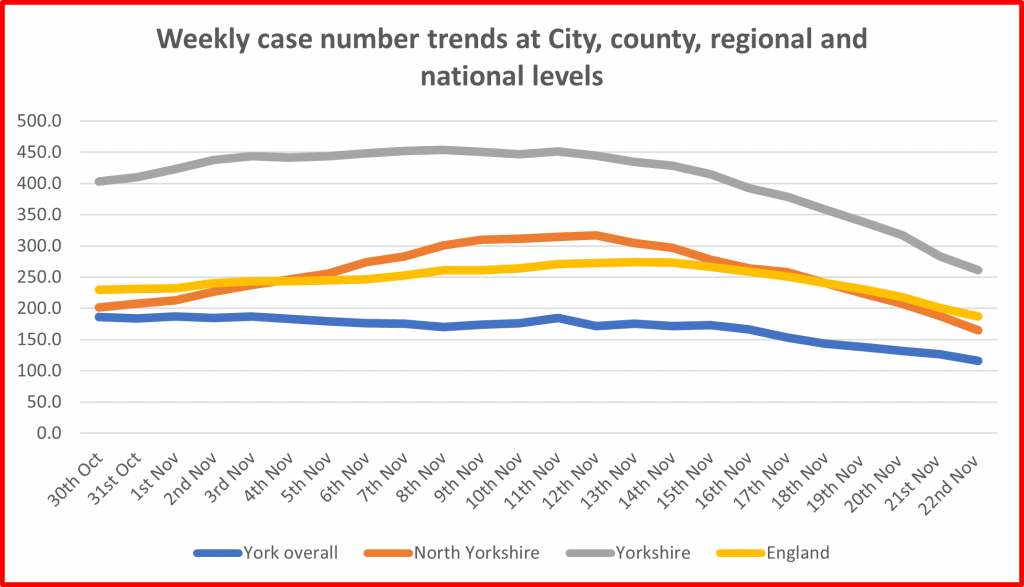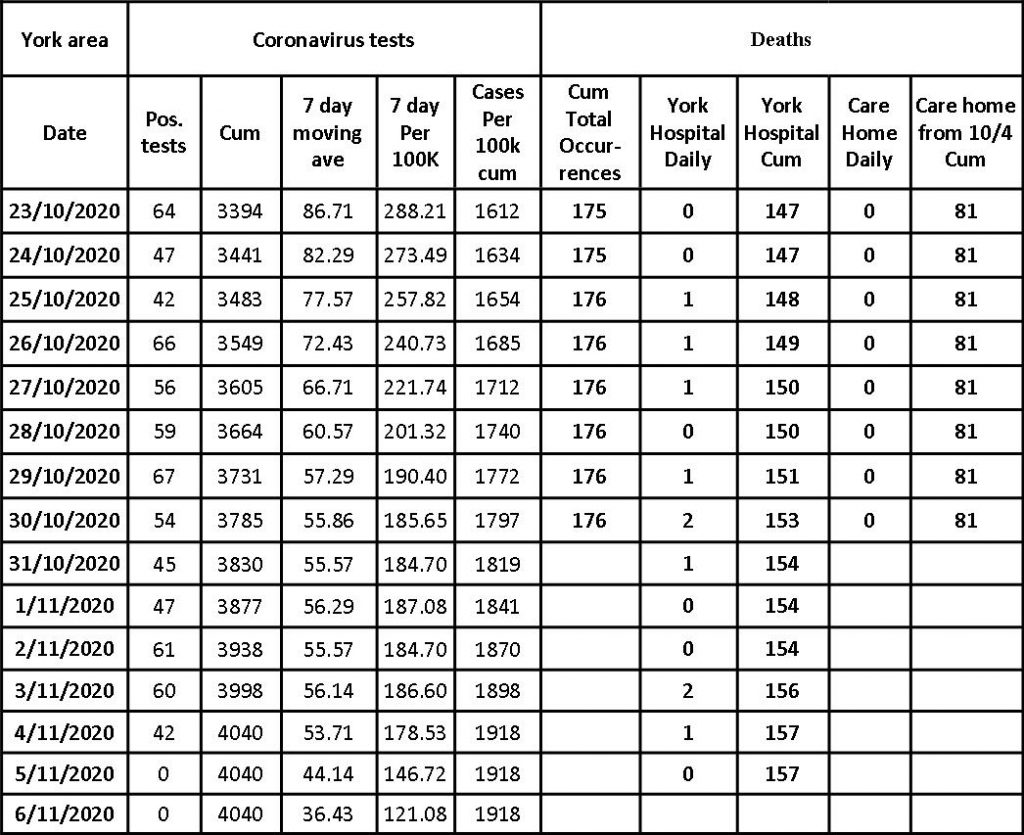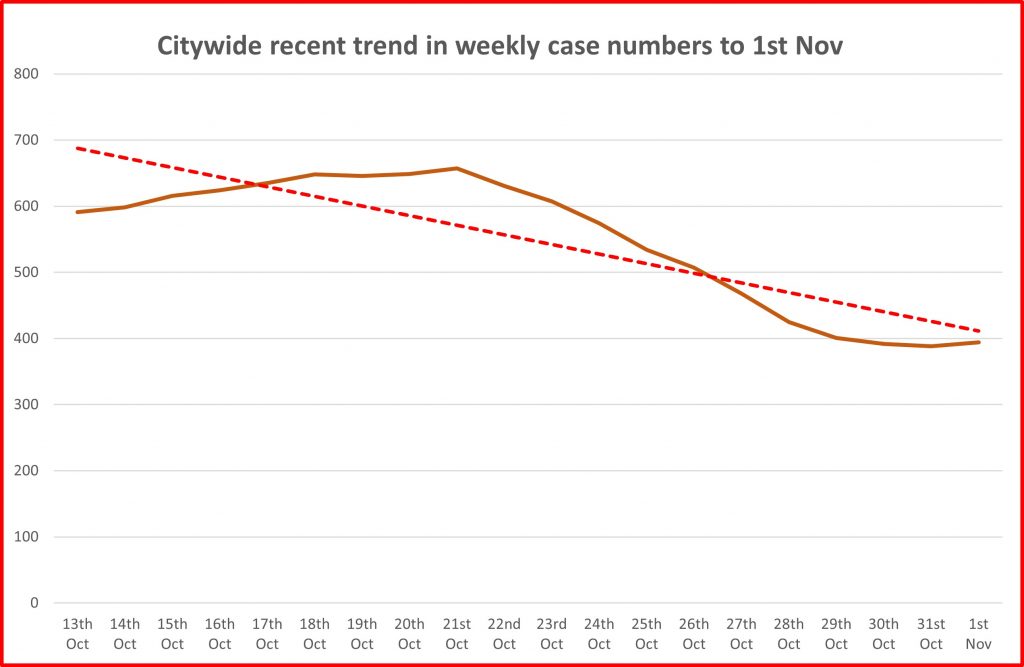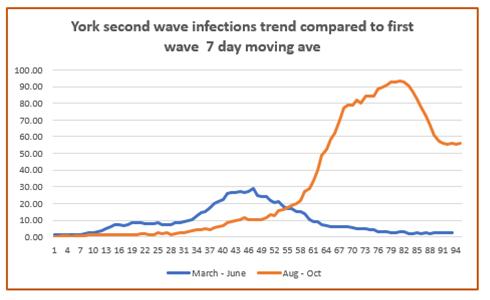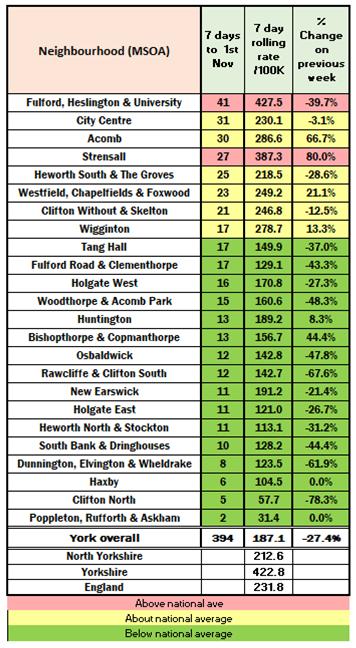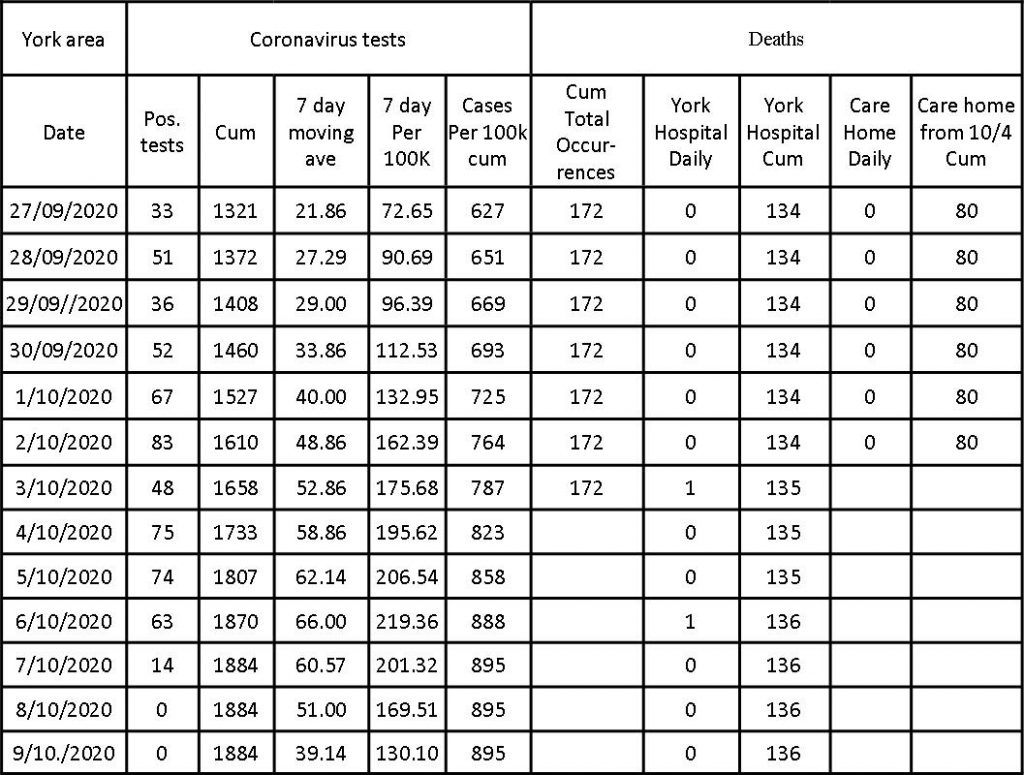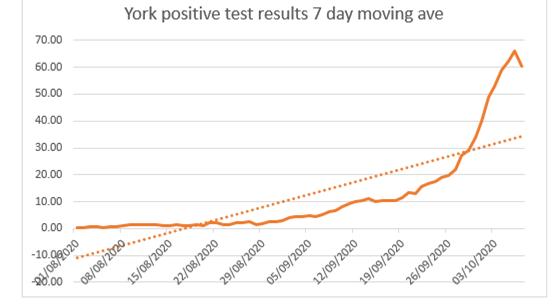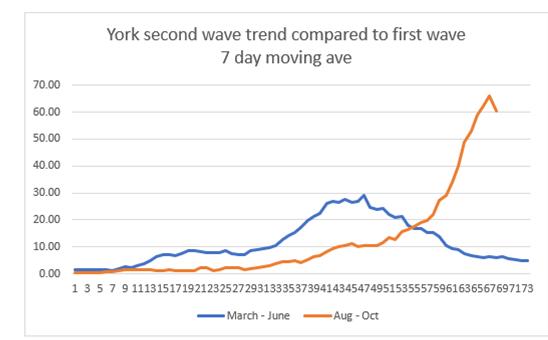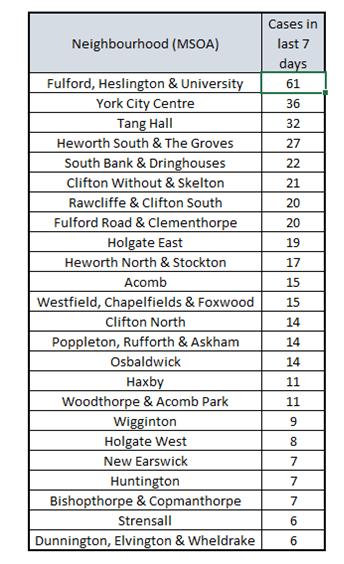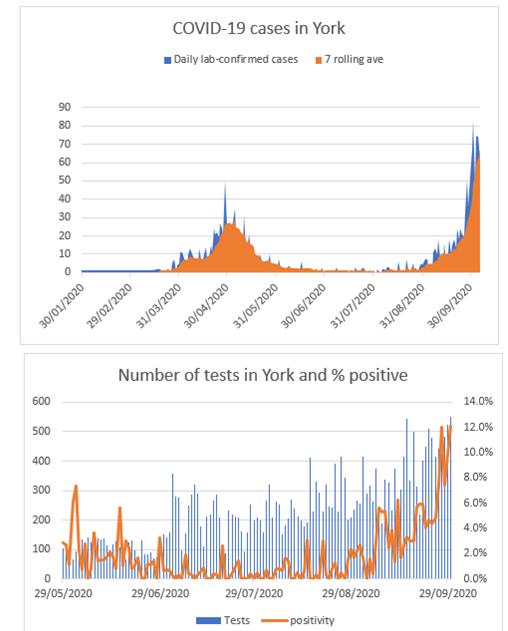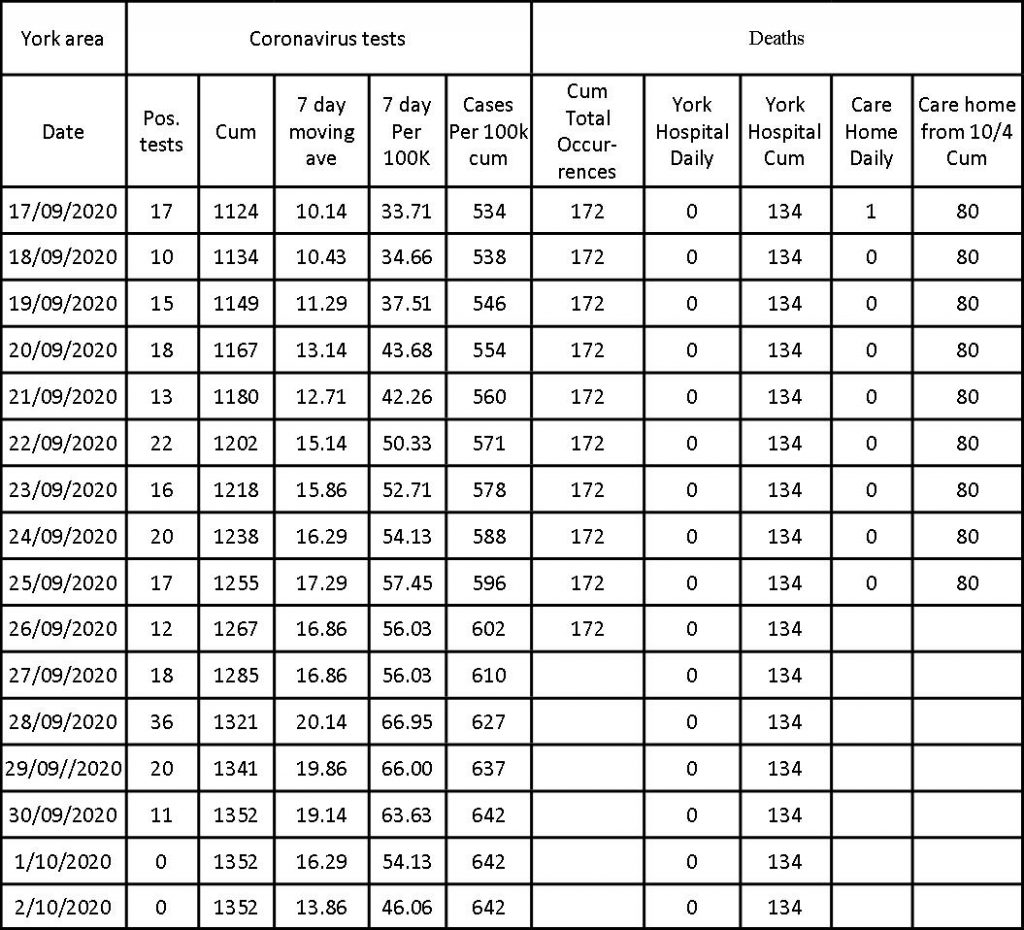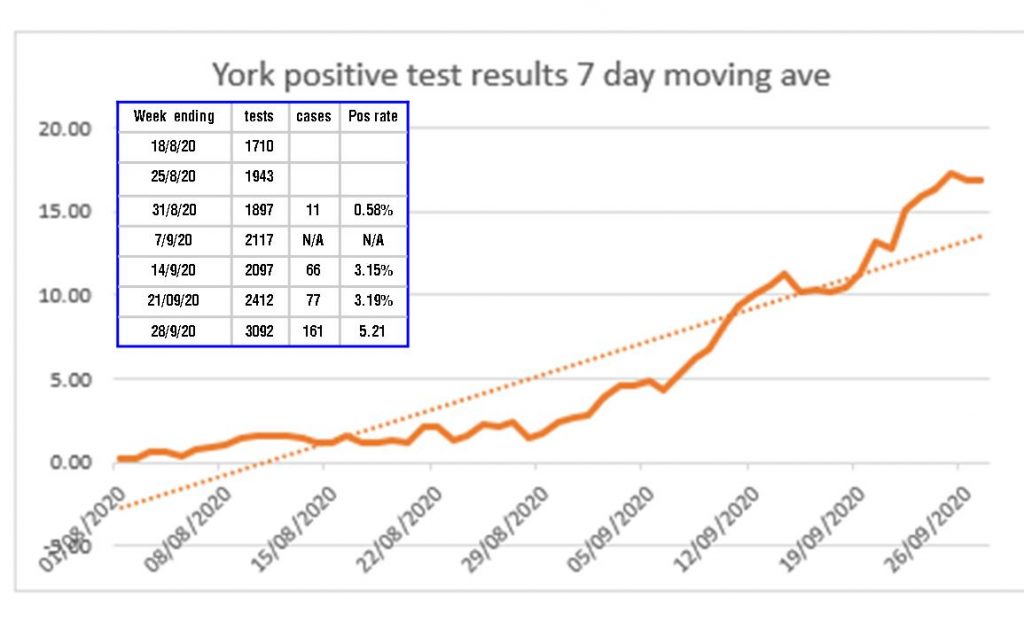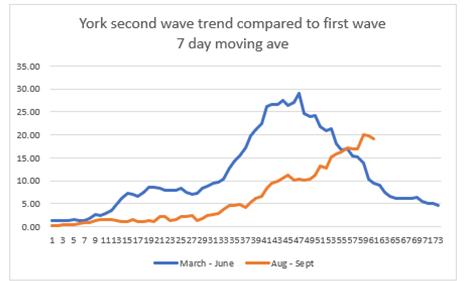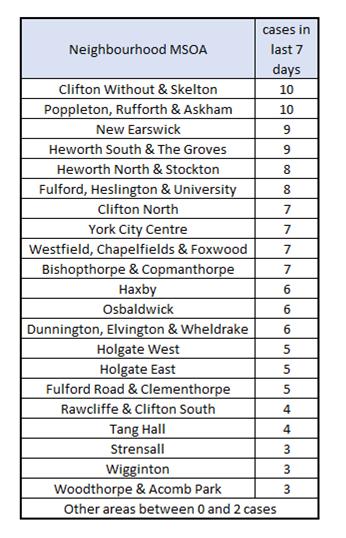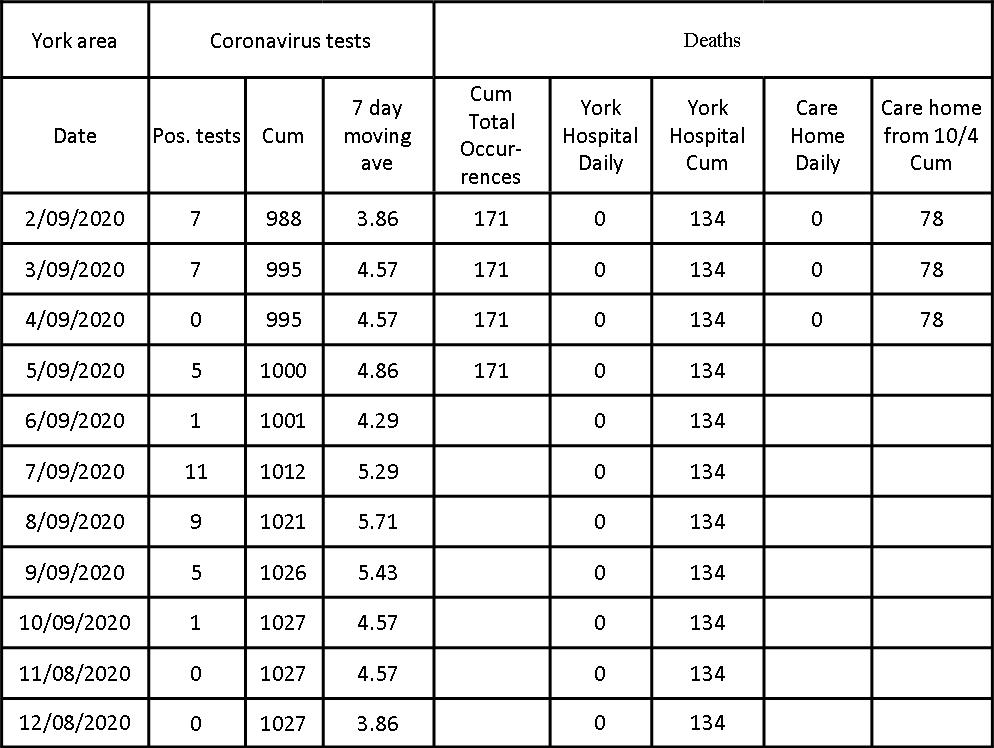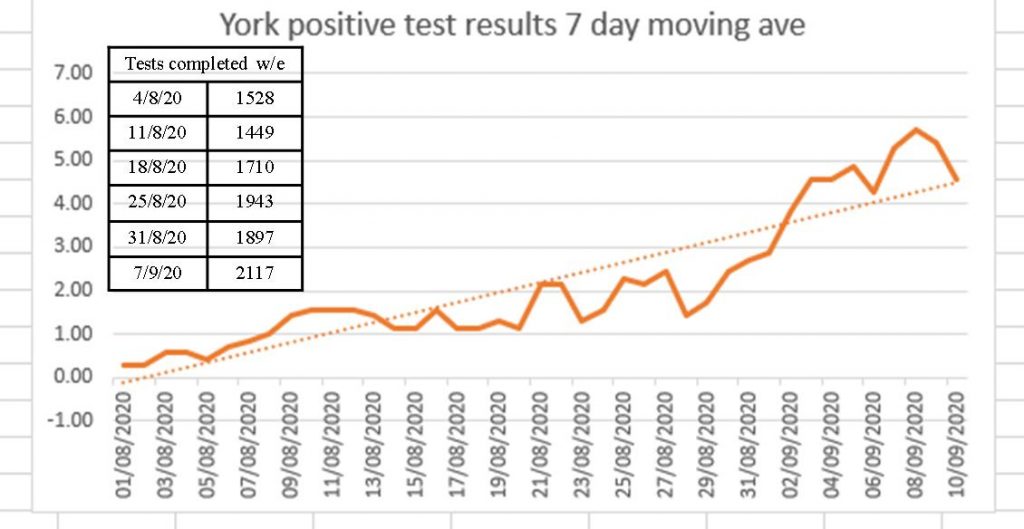Deaths and test results
TWO more York Hospital Trust deaths announced today. One occurred on Wednesday and one on Thursday. The cumulative second wave death toll at the York and Scarborough hospitals has now reached 112.
TWENTY SEVEN (27) additional positive test results were announced today bringing the cumulative total to 5858.
The case rate /100k population has increased to 65.5.

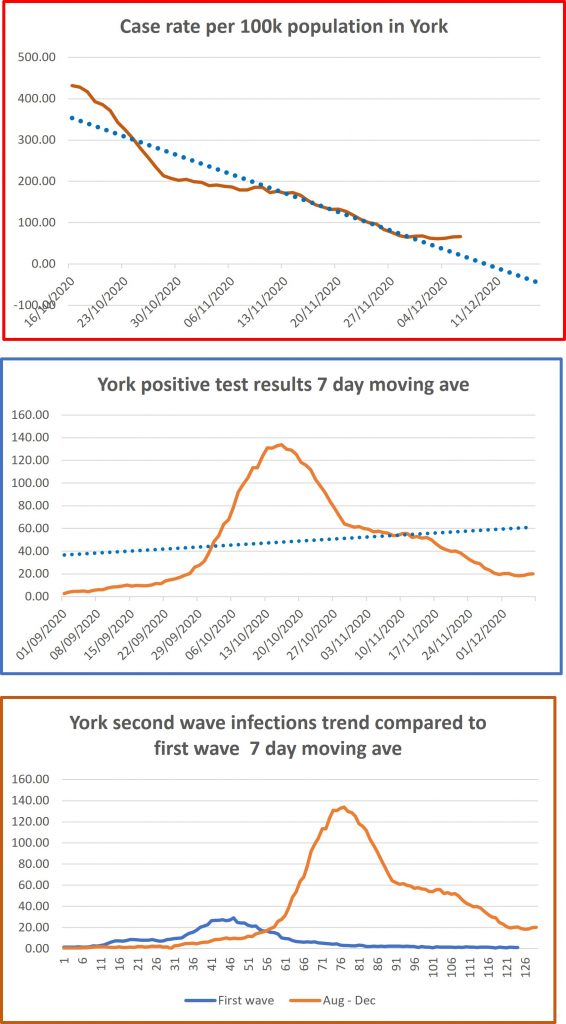
Although infection rates are rising again, cases aren’t concentrated in particular neighbourhoods. (In October, Heslington was by far the worst hit area).
Now only two neighbourhoods have more than 10 cases. The highest case rate can now be found in Acomb (124.2). However this is still well below regional and national averages.
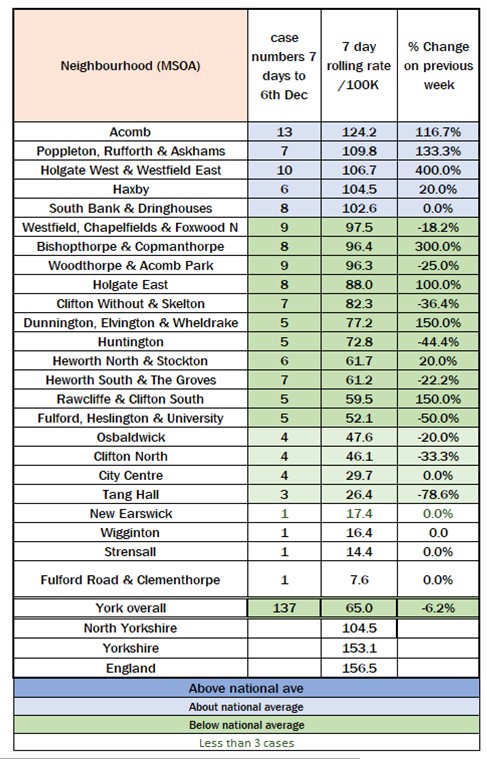
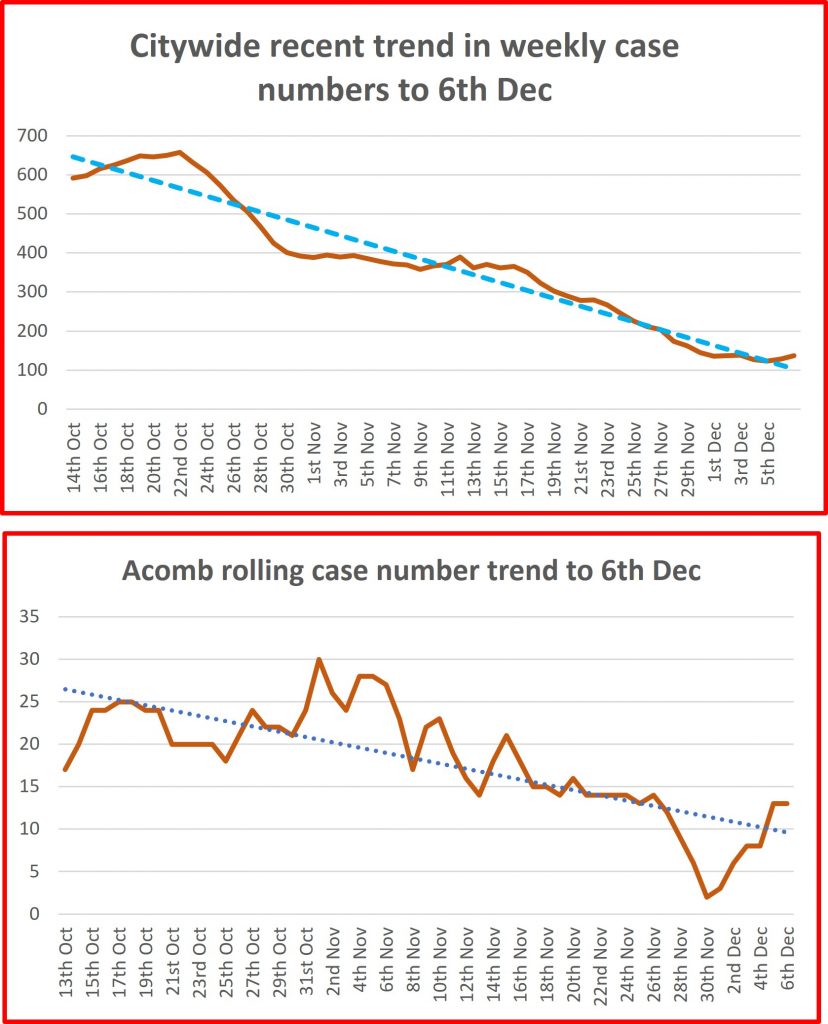
Booking open for York’s targeted symptom-free covid testing
Covid testing for people who are symptom-free is now available in York, as part of the city’s bid to further drive down the spread of the virus.
Booking for the free rapid symptom-free tests is now open for individuals who come into contact with lots of other people as part of their work.
At a meeting of York’s Outbreak Management Board, partners from across the city agreed to make targeted tests initially available to residents who work in the retail, hospitality or transport sector (including taxi drivers).
The Council will be looking to further roll out enhanced symptom-free testing in the coming months, extending it to other groups, such as those who have contact with vulnerable people through work, a voluntary role or unpaid caring role.
Around one in three people who have coronavirus have no symptoms and will be spreading it without realising it. The rapid-turnaround lateral flow tests, which provide results within 30 minutes, will be used to proactively test asymptomatic individuals. This will further support the local effort to drive down the city’s infection rate, as those who test positive and their contacts will be asked to self-isolate.
Tests for people working in the retail, hospitality or transport sectors, and who are free of Coronavirus symptoms, will be available to book online by visiting the council website.
Individuals who can’t access booking online can call 01904 551 559 to arrange an appointment. The booking line is open from Monday to Friday, 9am to 5pm.
Anyone who has Coronavirus symptoms should not book a symptom free test. They should self-isolate at home, and book a covid test through the NHS website or calling 119.
The Council is jointly working with York St John University to use Foss Sports Hall on the university’s Lord Mayor’s Walk Campus for the symptom free testing. The facility was used for their successful testing programme before students returned home for the holiday period.
Cllr Keith Aspden, Leader of City of York Council and Chair of the York Outbreak Management Advisory Board said:
We are hugely grateful to York St John University for allowing us to utilise their testing site for the next few weeks.
“We want to build on the successful targeted testing both universities carried out in recent weeks. This is another example of how York is coming together to fight the pandemic and ensure we are doing all we can to protect our city.
“I would urge those that are eligible to book their tests to help keep the people we love safe and the places we love open.”
Sharon Stoltz, Director of Public Health said:
We are taking a targeted approach to testing to help protect the city and slow the spread of the virus.
“Identifying asymptomatic cases is another form of defence for the city against Coronavirus. The early identification of positive cases and subsequent self-isolation will help us slow the spread.
“We urge all those who are eligible to book regular tests to help in the city’s fight against Coronavirus. Anyone who has symptoms should continue to book their test online or call 119.
“Whilst this is another defence to help us slow the spread we can’t lower our guard and must all continue to do all we can to practice Hands, Face, Space to stay safe and protect those around us.”
Professor Karen Bryan, Vice Chancellor of York St John University said:
Our University community has found the testing process to be quick and easy. Symptom-free testing can offer peace of mind to those concerned about passing on the virus to others. We are delighted to offer our test site to City of York Council to make targeted testing more widely available to our local community.”
Health Minister Lord Bethell said:
We’ve already come so far since first setting up a national testing programme at an unprecedented pace to help counter COVID-19, but we continue to strive to go further, faster.
“Innovations such as lateral flow tests hold the key to the next phase of our ambition to see mass, rapid testing available to people across the country.
“I’m delighted that the City of York Council and York St John University are working with us to pilot the latest technology in York and I look forward to seeing the fruits of their labour, both in helping target the virus locally, and helping find ways to roll this technology out further soon.”
More information about the tests and how to book one is available on the Council website.
Council commentary updated
The Council have updated their weekly “open data” commentary on the pandemic.
People with Covid Symptoms
• NHS Pathways/111 triages – as at 7.12.20 there had been 133 total covid triages in the CYC area in the last 7 days. The peak number of triages was 653 in the 7 day period to 20.9.20.
• As at 9.12.20, the Covid Symptom App estimates 320.2 per 100,000 in York with symptomatic covid (responses from a sample of 4,538 people). The peak rate was 1,116.3 on 31.10.20.
Diagnosed cases (Pillar 1&2 combined)
• As at 10.12.20 York has had 5,831 cases since the start of the pandemic, a rate of 2,768.5 per 100,000 of population. The cumulative rate in York is above the national average (2,721.3) but below the regional average (4,093).
• The PHE ‘Exceedance’ rating compares the no. of new cases over a 14 day period with the previous 6 weeks and provides a RAG rating to indicate if the previously observed trend in the no. of new cases is worsening. The latest rating for York (7.12.20) is Green.
• The provisional rate of new Covid cases per 100,000 of population for the period 2.12.20 to 8.12.20 in York is 57 (using data published on Gov.uk on 10.12.20).
• The latest official “validated” rate of new Covid cases per 100,000 of population for the period 29.11.20 to 5.12.20 was 60.8. The national and regional averages at this date were 153 and 156.2 respectively (using data published on Gov.uk on 10.12.20).
• The rate of new Covid cases per 100,000 of population for the period 28.11.20 to 4.12.20 for people aged 60+ in York was 76.7. The national and regional averages were 113.2 and 141.9 respectively.
• The positivity rate in York has fallen since a peak of almost 18% in mid-October. As at 9.12.20, the latest 7 day positivity rate in York (Pillar 2 only) was 1.95%. The national and regional averages are 6.1% and 5.9% respectively. The breakdown for York over the last 7 days by type of test is 124 positives out of 2.975 lab based (PCR) tests and 3 positives out of 3,537 rapid (lateral flow) tests.
• As at 10.12.20 York University reported 11 individuals within the University community who were currently self-isolating because they have had a positive COVID-19 test. The peak number was 331 on the 19.10.20.
• As at 9.12.20 York St. John reported 1 individual within the University community who was currently self-isolating because they have had a positive COVID-19 test. The peak number was 82 on the 8.10.20.
Contact Tracing
• Since 28.5.20 a total of 4,680 laboratory confirmed CYC Covid cases have been uploaded into the NHS Test and Trace system and 4,137 of the cases have been completed (88.4%). 13,212 ‘contacts’ have been identified and 7,992 of these have been completed (60.5%). Source: PHE Report.
• Local Tracing of Cases: Between 22.10.20 and 4.12.20, 339 ‘actionable’ positive COVID-19 CYC cases have been referred to the local contact tracing service. 339 of the referrals (100%) have been actioned. Of the referrals actioned, 247 (72.9%) were successful and 92 (27.1%) were unable to be reached via phone or home visit, but guidance leaflets were posted where possible.
Cases in Residential Settings / Schools
• As at 10.12.20 there were 0 care homes in the CYC area with confirmed Covid-19 infection (at least 1 case of either a staff member or resident).
• The latest ‘outbreak’ (2+ cases) in a residential care setting in York was reported on 25.11.20 (1 home).
• In the 7 days up to 6.12.20 there were 10 children of primary and secondary school age who tested positive (across 7 different schools).
COVID Bed Occupancy in York Hospital
• As at 9.12.20 there were 31 confirmed Covid-19 patients in General and Acute beds. The previous figure on 8.12.20 was 34.
• As at 9.12.20 there were 3 confirmed Covid-19 patients and 0 suspected Covid-19 patients in the Intensive Treatment Unit. The previous figures on 8.12.20 were 4 and 0 respectively.
• As at 9.12.20 there had been 0 patients admitted with suspected Covid-19 and 1 with confirmed Covid-19 in the previous 24 hours
Recovery from Covid-19
• Between 13.4.20 and 6.12.20, 257 CYC residents had recovered and been successfully discharged from York hospital after needing NHS care for symptoms linked to covid-19 infection. 7 people were discharged in the most recent week.
R Number
• The ‘R’ value (the number of people that one infected person will pass on a virus to, on average) for the North East and Yorkshire area on 4.12.20 was estimated to be in the range 0.7 to 0.9. The previous estimate was (0.8 to 1.0) on 27.11.20.
Deaths
The two sources about deaths from Covid-19 at LA level are ONS data and local registrar data. They are derived from the same source (civil registration data). ONS data is more comprehensive as it includes deaths of York residents which have occurred and been registered outside York. Local registrar data is useful as it provides a breakdown by age and gender. The most recently available data is summarised below:
• ONS weekly data: For deaths occurring up to 27th November 2020 and registered up to 5th December 2020, 196 Covid-19 deaths were recorded as having occurred for CYC residents (95 in hospital, 86 in care homes, 11 at home and 4 in a hospice). The number of deaths per 100,000 of population in York is 93.06 which is lower than the national average of 111.88. There have been 24 Covid-19 deaths of CYC residents reported by ONS in the last 8 weeks (Weeks 41 to 48).
• ‘Excess’ deaths – all causes (ONS). Between week 2 and week 48 there were a total of 137 ‘excess deaths’ in York compared with the average weekly numbers for 2014-2018. The breakdown over the year so far is: 18 fewer deaths in weeks 2-14, 210 more deaths in weeks 15-21 (when covid deaths were at their peak) and 55 fewer deaths in weeks 22-48.
• Local Registrar data: In the weekly data received on 7.12.20 (for deaths occurring up to 2.12.20), a cumulative total of 193 deaths of CYC residents where COVID-19 was mentioned (confirmed or suspected) on the death certificate, have been registered. The average age of the people who died was 82.5, with an age range of 53-104. The age profile of those dying in York is older than the national average. 96 of the 193 were male (49.7%), less than the national average (55.4%). 82 people (42.5%) died in nursing /care homes; (the national average is 26.53%). In addition 16 people (8.29%) who normally resided in nursing/care homes in the CYC area, died in hospital.
Shop local and continue to protect your loved ones
City of York Council thank residents for continuing to follow guidelines, resulting in a steady decline in local COVID-19 cases.
Councillors are urging residents to continue in their efforts to stop the spread of the virus and support local businesses this festive weekend.
The latest figures for York, as of December 5, show 60.8 cases per 100,000 compared to a national average of 153 and a regional average of 156.2 per 100,000. For a daily update on the latest case data, residents can visit the council’s Facebook and Twitter pages or the Open Data COVID-19 Daily Data Tracker.
Nationally, this week has marked the start of the biggest vaccination programme that the NHS has ever undertaken, and is a positive move towards overcoming the virus. However, to keep York’s local COVID-19 case rate low, residents are being urged to keep up their efforts and to remember the essential steps we must each take to keep our loved ones safe:
- Wash your hands regularly with soap and water.
- Wear a face covering in busy public spaces.
- Give people space and keep apart from people you don’t live with (2m is best).
- If you have symptoms you should stay at home, only leaving to get a test.
- Self-isolate when asked to by test and trace as well as if you have symptoms.
- Meet those you do not live with outdoors but not in groups of more than six
Next week, on Wednesday 16 December, at 5:30pm, the Council will be hosting their next ‘Ask the Leaders’ Facebook Live Q&A session. The panel will be discussing the Coronavirus Vaccine, Christmas guidance and emotional wellbeing support.
Residents are invited to submit questions in advance by emailing YourQuestions@york.gov.uk or asking them live during the session at www.facebook.com/cityofyork.
Recordings of previous Q&A sessions are available here: www.york.gov.uk/AskTheLeaders
Councillor Keith Aspden, Leader of City of York Council said:
“I’d like to once again thank all York residents and businesses who continue to work hard to help bring the city’s case rate down.
“As the vaccine roll-out commences, we cannot afford to be complacent and must continue in our efforts to keep our city and each other safe.
“In York we are lucky to have such an amazing variety of local independent businesses, who have all played a key role in our efforts against the virus. The best way we can say our thanks is by shopping local and supporting them this festive season.”
Sharon Stoltz, Director of Public Health at City of York Council said:
“As our attention has been draw to the hope of the vaccine roll-out this past week, myself and York’s Public Health team look forward to helping colleagues in the NHS with the delivery of programme. In the meantime, Hands, face, space remains the best defence against the virus for York residents, and we must all make sure we continue to follow government guidance.
“Over the coming weeks it’s important we look after both our physical and emotional health. Simple steps can make a great difference and I encourage residents to look out for vulnerable friends and family this winter season. Winter health tips include:
- Keep warm – The temperature in your home should be at least 18 degrees. If you need help with fuel bills, grants may be available.
- Get a flu vaccine – Many people, including those aged over 65, are entitled to a free flu jab – your GP will contact you if you are eligible.
- Eat a healthy diet and try to ensure you have regular meals and warm drinks throughout the day.
- Keep well stocked up with prescription medicines, especially as the festive season approaches. Ask your pharmacist for advice if you aren’t sure what you need.
Check on elderly or medically vulnerable neighbours and relatives, particularly in icy weather. This can be done in a Covid-safe way, either by telephone or a socially distanced doorstep chat.”
If you’re struggling to manage, or you don’t have any support, but need it because of COVID-19, the council’s COVID-19 Helpline for York may be able to help you through this difficult time. Please call 01904 551550 or email COVID19help@york.gov.uk . Residents can also visit www.york.gov.uk/Coronavirus to find out the most recent support and advice available for the area.

